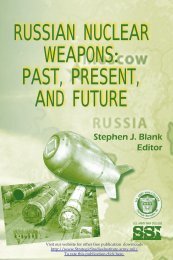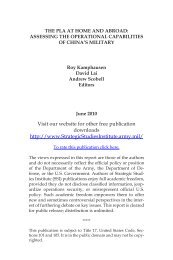The United States and China in Power Transition - Strategic Studies ...
The United States and China in Power Transition - Strategic Studies ...
The United States and China in Power Transition - Strategic Studies ...
You also want an ePaper? Increase the reach of your titles
YUMPU automatically turns print PDFs into web optimized ePapers that Google loves.
pher at his confirmation hear<strong>in</strong>g, “Our policy will seek to facilitate<br />
a peaceful evolution of <strong>Ch<strong>in</strong>a</strong> from communism to democracy. . . .,”<br />
U.S. Senate Foreign Relations Committee, January 13, 1993. In addition,<br />
there is a large literature on U.S. engagement policy toward<br />
<strong>Ch<strong>in</strong>a</strong>.<br />
28. See Henry Kiss<strong>in</strong>ger, Diplomacy, New York: Simon &<br />
Schuster, 1994, for an excellent account of the evolution of the U.S.<br />
beliefs <strong>in</strong> the world order <strong>and</strong> its mission to promote it. Review<br />
also Francis Fukuyama’s “<strong>The</strong> End of History?” National Interest,<br />
Summer 1989.<br />
29. See the literature on “democratic peace” from the early<br />
1990s on for its <strong>in</strong>fluence on the U.S. sense of mission <strong>and</strong> its determ<strong>in</strong>ation<br />
to promote democracy <strong>in</strong> the world. See also the U.S.<br />
National Security Strategies from the George H. W. Bush adm<strong>in</strong>istration<br />
to the latest National Security Strategy of 2010.<br />
30. President George W. Bush’s National Security Strategies of<br />
2002 <strong>and</strong> 2006 have perhaps the strongest words on <strong>Ch<strong>in</strong>a</strong>’s <strong>in</strong>complete<br />
transition to modernity <strong>and</strong> its role as a stakeholder.<br />
31. American analysts also agree that democratic peace theory<br />
may not be as solid as the proponents have established. Recent<br />
studies cont<strong>in</strong>ue to challenge the theory.<br />
32. Samuel P. Hunt<strong>in</strong>gton, Political Order <strong>in</strong> Chang<strong>in</strong>g Societies,<br />
New Haven, CT: Yale University Press, 1968. Ch<strong>in</strong>ese government<br />
<strong>and</strong> policy analysts have always used Hunt<strong>in</strong>gton’s theory<br />
to justify <strong>Ch<strong>in</strong>a</strong>’s authoritarian rule. Readers may want to review<br />
Joseph T. Siegle, Michael M. We<strong>in</strong>ste<strong>in</strong>, <strong>and</strong> Morton H. Halper<strong>in</strong>s’<br />
challenge to Hunt<strong>in</strong>gton’s work <strong>in</strong> their study on “Why Democracies<br />
Excel,” Foreign Affairs, September/October 2004.<br />
33. Li Zhongzhou, “An Irresponsible Stakeholder,” <strong>Ch<strong>in</strong>a</strong> Daily,<br />
June 26, 2007.<br />
34. I use the term “construct” for the lack of a better word.<br />
Ch<strong>in</strong>ese unqualify<strong>in</strong>gly call the harmonious world construct a<br />
“theory.” This is a typical Ch<strong>in</strong>ese misuse of the term “theory” <strong>in</strong><br />
<strong>Ch<strong>in</strong>a</strong>. <strong>The</strong> harmonious world is more of a Ch<strong>in</strong>ese government<br />
foreign policy call. Xu Shaom<strong>in</strong> (许少民) is one of the very few<br />
208

















